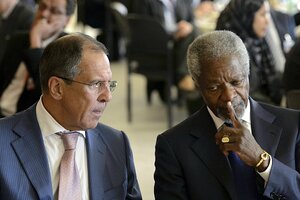Not much progress at Geneva meeting on Syria violence
World powers agreed Saturday on a plan for ending Syria’s violence – but only by sweeping under the rug unresolved differences over the role Bashar al-Assad should play in a political transition.

Kofi Annan, right, Joint Special Envoy of the United Nations and the Arab League for Syria, speaks with Russian Foreign Minister Sergey Lavrov after a meeting of the Action Group for Syria at the European headquarters of the United Nations, in Geneva, Switzerland, Saturday.
Laurent Gillieron/AP
WASHINGTON
World powers including the United States and Russia agreed Saturday on a plan for ending Syria’s violence – but only by sweeping under the rug their unresolved differences over the role Syrian President Bashar al-Assad should play in a political transition.
As a result, the plan endorsed by the five permanent members of the United Nations Security Council and a group of regional powers in Geneva Saturday seemed unlikely to reverse Syria’s slide toward all-out war – a slide some leaders and regional experts have warned could degenerate into a dangerous regional conflict.
The watered-down plan, based on a stronger proposal initiated by UN and Arab League Syria envoy Kofi Annan, calls for a transitional government whose participants would be determined by Syrians. The plan also calls on the Syrian government forces and the rebels to recommit themselves to a cease-fire called earlier this year that never took hold.
Syria conflict: 5 warring factions
Mr. Annan said after the meeting that the adopted plan could take a year to implement – a long stretch of time that seems almost certain to witness more violence, especially since the plan includes no incentives for or constraints on the warring factions.
Annan’s original plan had implicitly ruled out participation in any political transition by Mr. Assad and his closest lieutenants associated with more than a year of horrendous bloodletting. But Russia stood by its objections to any international action compelling Assad to step down.
The new plan allowed Secretary of State Hillary Rodham Clinton to insist in remarks after the meeting that Assad is closer than ever to falling from power. Assad “will still have to go, he will never pass the mutual consent test given the blood on his hands,” Secretary Clinton said.
But she added that it is now up to Russia and China, who have stood in the way of other international initiatives on Syria, to work from the plan they joined in adopting Saturday to ease Assad out of power.
“It is now incumbent on Russia and China to show Assad the writing on the wall,” she said. Clinton had met one-on-one with Russian Foreign Minister Sergei Lavrov in Saint Petersburg Friday, but had been unable to win Russia’s acceptance of even an implicit call for Assad to give up power.
The vagueness of the plan adopted Saturday suggested that world powers decided it was better to have a weak outcome than to announce their failure to come together over a crisis that many leaders and regional experts have warned for months could end up sparking a broader conflict.
Mr. Annan reminded the meeting’s high-level officials of the serious consequences of failure in his opening remarks. “No one should be in any doubt as to the extreme dangers posed by [this] conflict – to Syrians, to the region, and to the world,” Annan said.
Ever since Syria’s Arab-spring uprising descended into sustained violence over a year ago, a rising chorus of voices has cautioned that Syria was different from other Arab countries swept up in the revolutionary tide – Tunisia, Egypt, Libya, Yemen, Bahrain – and that war in Syria was the one that could engulf the region.
With neighbors that include Turkey, Lebanon, Iraq, and Jordan – not to mention Israel – Syria and full-blown conflict there was most likely to drag in the neighbors’ allies, including the US and NATO, Russia and Iran, experts warned.
The dangers the Syria conflict poses to regional stability were highlighted last week when Syria shot down a Turkish fighter jet, prompting Turkey to call a meeting of its NATO partners. The conflict has also spilled over in a variety of ways into Lebanon and Jordan, while reports that Al Qaeda operatives are crossing over from Iraq to carry out attacks in Syria has set off alarms in Washington.
None of those worrisome developments are likely to improve as long as Syria remains in turmoil and deepening violence, yet international calls for Syrians to somehow come together on their own on a political transition seem unlikely to end the crisis. Assad continues to insist his government is in “all-out war” with “terrorists,” while the Syrian political opposition and the rebels’ Free Syrian Army say there is no chance of an accord with any elements of the Assad regime.
Earlier this week Assad said in an interview with Iranian television that the Syrian crisis could not be resolved from the outside but can only be addressed with a “national model,” one he certainly assumes would include him remaining in power.
Assad, who dismissed the “Libyan model” in the interview as having no relevance to Syria’s case, seems prepared to fight on, especially as he is convinced he can count on the protection of powerful Allies like Russia.
“Let’s keep in mind that Assad has every incentive to continue to fight. He has no place to go,” says Steven Cook, a senior fellow at the Council on Foreign Relations in Washington.
Add to that the fact that the Syrian Free Army, even though it has “grown more capable … remains no match for the Syrian military,” Mr. Cook says. Assad’s forces, he adds, have “proved to be surprisingly resilient.”

